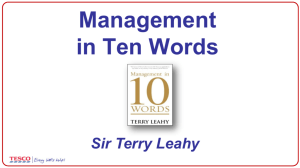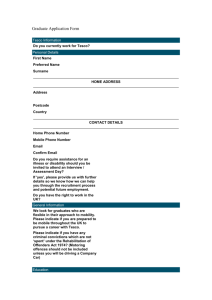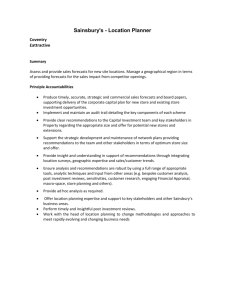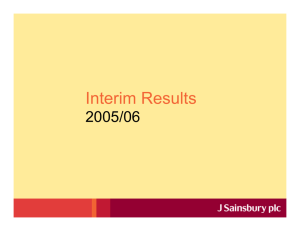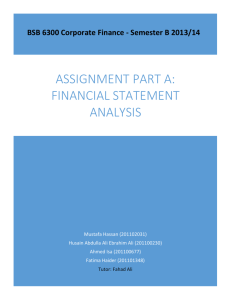File - Mustafa Hassan
advertisement
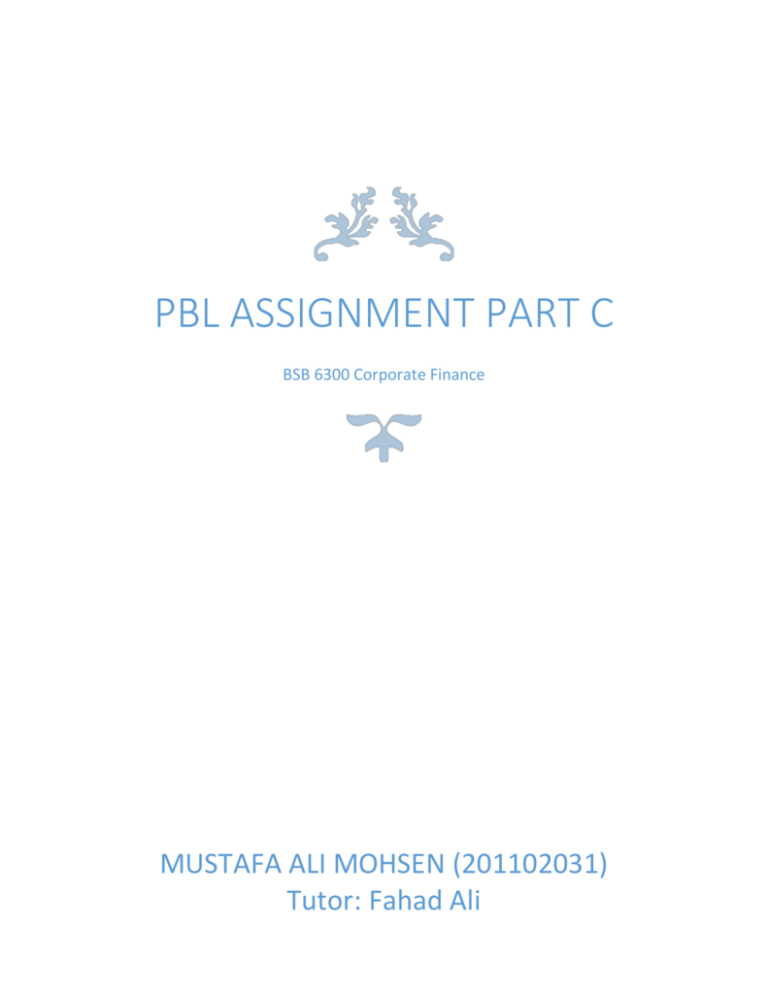
PBL ASSIGNMENT PART C BSB 6300 Corporate Finance MUSTAFA ALI MOHSEN (201102031) Tutor: Fahad Ali Q1: Dividend Valuation Model: is model used to evaluate the share price by predicting the future dividends and discounting them by the present value. Higher DVM value than the trading share price suggests that the share price is undervalued. (Investopedia, 2009) Comparing findings: Based on the dividend valuation model the intrinsic value of Sainsbury’s share is 343.44, and the share price in December 2008 was 365 pence. As result of these findings, we can say that the share price is overvalued and based on this figure only this investment is bad. Year Growth 2008 Dividend PV of Dividend 13.20 2009 8% 14.26 13.10 2010 2011 2012 2013 SS 9% 9% 8% 7% 4% 15.54 16.94 18.29 19.57 20.36 13.13 13.15 13.05 12.84 278.17 DVM Share Value 343.44 Assumptions: We will assume that the beta will not change in the coming years because Sainsbury is a defensive, matured and large corporation and it need large transactions to be affected, and the same for the risk free rate as we will assume that the market will be stable. In the other hand, in the calculations we have assumed that the risk premium will be fixed over the coming years at 6%, and if we assumed that the risk premium will decrease in the coming years then the share value will increase. Furthermore, assuming that the Dividends will be growing at the riskless rate of 4% to infinity after 2013 is unrealistic. Therefore, if we assumed that there will be an increase in the growth rate for the dividend after 2013 then there will also be an increase in the share value. Q2: The Free Cash Flow model: is used to evaluate the financial performance of a company, as the free cash flow shows how much the company can generate after paying its expenses. (Investopedia, 2009) Comparing findings: As Estimated by the free cash flows valuation model the Sainsbury enterprise value is 434.07, while the company share price in December 2008 was 365 pence; As a result of this estimation we can say that the share price in 2008 was undervalued, therefore investing in this share based on this estimation only will successful in the future. Terminal Value PV of Terminal Value PVFCF(2009-2013) Enterprise Value Value of Debt Value of Equity NOSH FCF PPS 14,866.11 10,681.85 1,148.15 11,830.00 2,331.00 9,499.00 1753 541.87 Assumptions: In the calculations we have assumed that the sales growth rate will stay at steady state of 4% over the coming years after 2013, which is not realistic. If we assumed that the growth will increase in the coming years then the FCF PPS will increase significantly. Furthermore if we assumed that the risk premium is going to decrease in the coming years, then the FCF PPS will also increase. Q3: Comparing findings to DEC.2008: Based on the Multiples Valuation Model the share value for Sainsbury is estimated at 448.51, and the actual share price in December 2008 was 365 pence. Therefore, based on this evaluation only we can tell that the share price is undervalued and we can assume that investing on this share will be good investment. EPS x CompP/E 290.33 Book Value x Comp P/B 594.99 CF * P/CF 418.77 EBITDA x Comp EV/EBITDA Value of Equity PPS 10193.46 7862.46 448.51 Comparing findings to Tesco: Sainsbury's Tesco comment Trailing P/E --> PPS/EPS The P/E ratio shows how much the investors are willing pay for the company’s share in comparison to the company’s earnings. The lower the better. 20.45 14.20 We can clearly see that Tesco has a higher P/E ratio than Sainsbury has, which means that the investors have to pay less for their earnings. with Sainsbury’s the investors will have to pay 20.45 GDP for each 1 GDP of earnings they gain each year, which means that it will take from the investors 20.45 years to cover their investing expenses. While in Tesco they have to pay 14.20 only for each 1 GPD of earnings. As a result, Tesco has a better P/E ratio than Sainsbury’s. Forward P/E -->PPS/EPSt+1 15.33 13.11 On the other hand, it is obvious that Sainsbury's is closing the gap between them and Tesco in the future. As a result the Forward P/E ratio is almost similar to Tesco, but Tesco is still better with 13.11 P/E ratio. P/B P/B ratio shows how much investors are rating the company’s stock value in compression to its book value. The higher the better. Any ratio above 1 means that the investors believe that the company will grow and expand in the future. Based on the P/B ratio, it seems that the investors have a more optimistic view of Tesco's shares with a ratio of 2.38 in comparison to Sainsbury’s 1.36. 1.36 2.38 The 1.36 ratio means that Sainsbury's stock price costs 1.36 times as its assets could be sold for, and it is actually a positive sign for Sainsbury which means that the investors believe that the shares worth more than the assets as they might grow in the future. P/CF 7.07 8.72 Based on the P/CF ratio, Tesco shares are more attractive for the investors than Sainsbury’s EV/EBITDA EV/EBITDA is a more accurate alternative for P/E ratio. Using this ratio we can determine whether the share price of a company is expensive or cheap, and in more accurate way than P/E ratio we can evaluate the share price 6.90 8.49 As a result of the EV/EBITDA ratio, it is obvious that Sainsbury is valued under Tesco but both of them are close in the valuation. Multiples Valuation Model pros & cons: Advantages Disadvantages 1- It requires very easy calculations. 1- It can be affected significantly if the company uses a different accounting method to calculate revenue. 2- It doesn't depends on assumptions like other valuation methods. 2- This method of valuation depends on historical data or near future forecasts, which means that this method won't be able to give the investor a clear valuations long-term future. 3- Finding a similar company to be used for the comparison can be difficult, especially if the company that is being evaluated has a unique kind of business. 3- The information that this model provided can be very helpful for investors to make an accurate investment decision. (Thepersonalfinancier.com, 2007) References Investopedia, (2009). Dividend Discount Model (DDM) Definition | Investopedia. [online] Available at: http://www.investopedia.com/terms/d/ddm.asp [Accessed 24 May. 2014]. Investopedia, (2009). Free Cash Flow (FCF) Definition | Investopedia. [online] Available at: http://www.investopedia.com/terms/f/freecashflow.asp [Accessed 24 May. 2014]. Thepersonalfinancier.com, (2007). Using Multiples for Valuations: Pros and Cons | The Personal Financier - A Personal Finance Blog. [online] Available at: http://www.thepersonalfinancier.com/2007/11/using-multipliers-for-evaluations-pros.html [Accessed 24 May. 2014].

